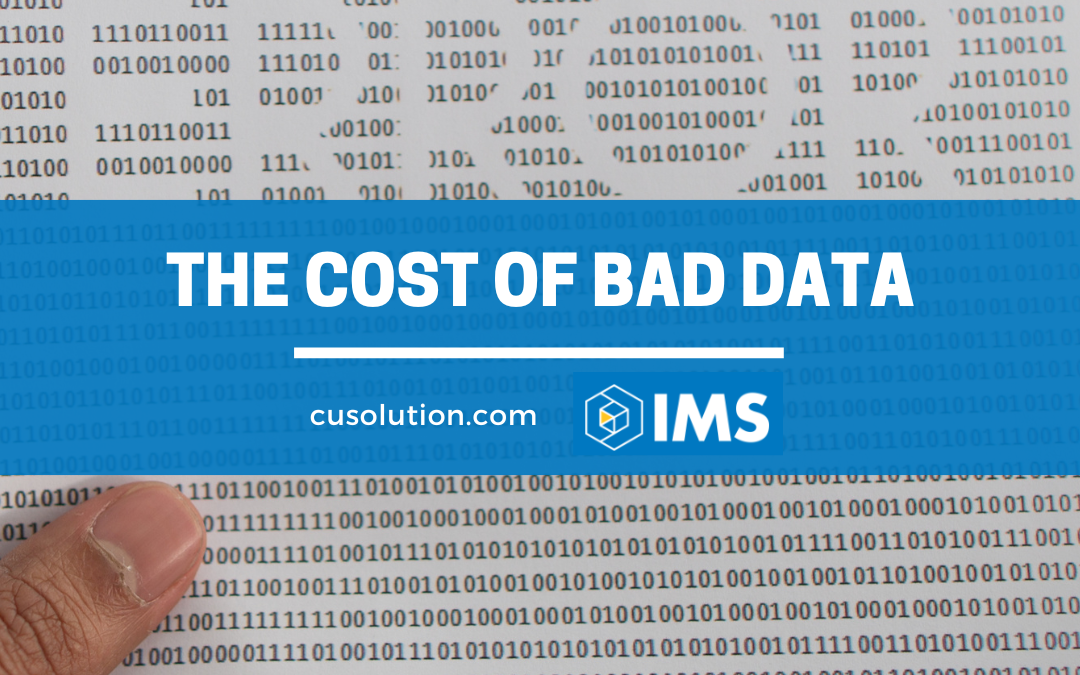Good data is essential for businesses, especially credit unions. But what many credit unions need to realize is that bad data can come with a hefty price tag. From decreased operational efficiency to missed opportunities to grow your business, the cost of bad data is real and often underestimated.
To help you understand these costs and how they can affect your credit union, we’ll examine the cost of bad data quality, how to identify it, and how you can prevent it from happening in the first place.
Data Quality: Why Bad Data is So Bad
We’ve featured bad data insights previously on the IMS blog in a past article about the ways bad data can harm your credit union. But the world is increasingly data-driven, and businesses are more reliant on intelligent data analytics, backups, recovery, and targeted solutions than ever before. And the amount of data being processed by financial institutions continues to grow in volume every year.
Improving data quality is a concern for businesses across all industries, and businesses in the financial sector are often under higher scrutiny than others. Because of this, keeping accurate data banks is so important for compliance items and for the reputation of your brand.
Bad Data Main Causes
You can’t escape bad data, you can only minimize it. And that means recognizing the causes of poor-quality data.
One of the most common causes is incorrect and incomplete data from members and/or employees. Miss one number in a member’s address on their loan application – that’s bad data. And that bad data can live on in a system for years if it’s not caught and corrected. Everyone knows the prevalence of the typo – in fact, if your surname isn’t one of the common ones in the USA like Smith, Johnson, or Williams, we can all but guarantee you’ve gotten one medical bill, marketing email, or other official correspondence with your name spelled wrong. Even when people are copying data or collecting information slowly and deliberately, missed keystrokes happen.
This is also true with incomplete data. There’s a reason why almost every form you fill out online has the little “*” next to items that are required, and every missed box triggers a “you missed something” notification that prevents you from even moving forward with the form submission. These are commonplace now because it’s a great and proactive way to make sure the bad data doesn’t come from someone submitting an incomplete document or request.
Bad data is also easily propagated through poorly maintained vendor and third-party files. This data is vital in helping your credit union learn more about financial trends across organizations and understand more about the current markets and business climate. But it also comes with the added knowledge that everyone stores and manages their data a bit differently.
This point leads us to another big cause of bad data – lack of standardization. Because handling and managing such massive amounts of electronic data is fairly new, especially for credit unions, there’s a lot of room for error in execution. And when your data is keeping track of people, it’s easy to create duplicate entries for the same person.
Think about it – even just one woman can be in your system several times – once with her maiden name, once with her maiden name and middle initial, once with her married name, and on and on it goes.
This Credit Union Times article goes into more detail about some of the most common causes of bad data.
The Cost of Bad Data for Your CU
Bad data management is a lot like learning how to drive a car, but never getting inside one. You can understand the value and benefits that knowing how to drive can give you, but you can’t reap any of those benefits, and if you don’t interact regularly with the car, you can’t improve your driving skills.
The same is true with data – if it’s not accessible, it’s not useful. Having all the data and not using it (or not investing in high data quality measures) is the same as not having it, in many cases.
When it comes to the monetary value of bad data costs, the figures are in the trillions, and that’s just for certain singular business ventures. Recently, IBM reported a loss of $3 billion due to bad data, and Gartner reports that poor data quality costs organizations $12.9 million on average.
And because bad data means a loss of trust in your credit union, the monetary losses are compounded by the decline in member numbers. And because banking services are necessary for nearly all facets of work and life, those members then turn to big banks and fintechs to house and store their financial and personal data. And younger generations aren’t messing around with their brand loyalty – they are more than willing to leave banks that break their trust.
Discover, Classify, Report: Positive Data Management
Bad data come in all shapes and sizes. Without a quality data management strategy, your credit union could fall
down a rabbit hole of data corruption, misplacement, and ultimately, member dissatisfaction.
To help combat bad data practices, IMS has an amazing SaaS application that uses machine learning to discover, classify, and report on sensitive data without impacting your day-to-day. We do this through our Polaris Sonar compliance technology.
With Polaris Sonar, you can use machine learning to automate processes and policies, identify exposures of sensitive data, and stay in compliance with all applicable privacy laws while mitigating the cost of bad data.
Reach out to us today to learn more about this and other IMS tools that are expertly tailored to promote higher data quality in your credit union.

